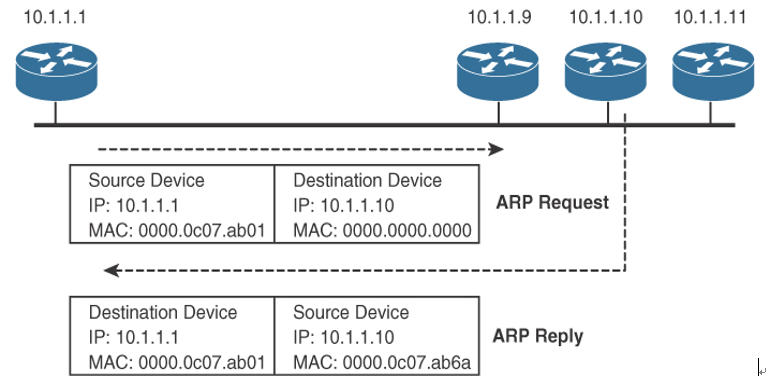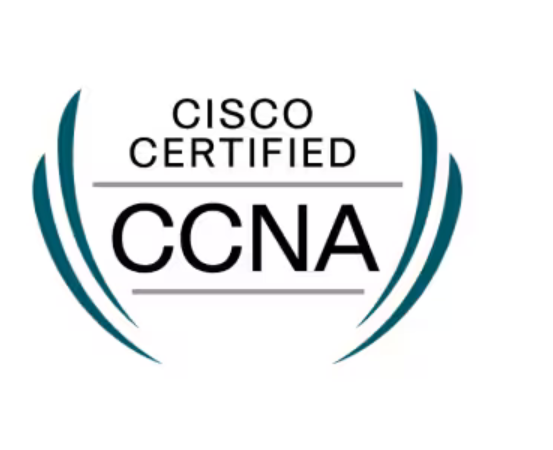When an IP host needs to send an IP packet over an Ethernet network, it needs to find out what 48-bit MAC physical address to send the frame to. Given the destination IP address, Address Resolution Protocol (ARP) obtains the destination MAC address. The destination MAC address can be a local host or the gateway router’s MAC address if the destination IP address is across the routed network. ARP is described in RFC 826. The local host maintains an ARP table with a list relating IP addresses to MAC addresses.
ARP operates by having the sender broadcast an ARP request. Figure 1-11 shows an example of an ARP request and reply. Suppose a router with the IP address 10.1.1.1 has a packet to send to 10.1.1.10 but does not have the destination MAC address in its ARP table. It broadcasts an ARP request to all hosts in a subnet. The ARP request contains the sender’s IP and MAC address and the target IP address. All nodes in the broadcast domain receive the ARP request and process it. The device with the target IP address sends an ARP reply to the sender with its MAC address information; the ARP reply is a unicast message sent to 10.1.1.1. The sender now has the target MAC address in its ARP cache and sends the frame.

Figure 1-11 ARP Request and Reply
References and Recommended Readings
RFC 791: Internet Protocol, www.ietf.org/rfc
RFC 826: Ethernet Address Resolution Protocol: Or Converting Network Protocol Addresses to 48-Bit Ethernet Address for Transmission on Ethernet Hardware, www.ietf.org/rfc
RFC 951: Bootstrap Protocol (BOOTP), www.ietf.org/rfc
RFC 1034: Domain Names—Concepts and Facilities, www.ietf.org/rfc
RFC 1035: Domain Names—Implementation and Specification, www.ietf.org/rfc
RFC 1349: Type of Service in the Internet Protocol Suite, www.ietf.org/rfc
RFC 1631: The IP Network Address Translator (NAT), www.ietf.org/rfc
RFC 1918: Address Allocation for Private Internets, www.ietf.org/rfc
RFC 2131: Dynamic Host Configuration Protocol, www.ietf.org/rfc
RFC 2474: Definition of the Differentiated Services Field (DS Field) in the IPv4 and IPv6 Headers, www.ietf.org/rfc
RFC 2597: Assured Forwarding PHB Group, www.ietf.org/rfc
RFC 2598: An Expedited Forwarding PHB, www.ietf.org/rfc
RFC 3022: Traditional IP Network Address Translator (Traditional NAT), www.ietf.org/rfc
RFC 3168: The Addition of Explicit Congestion Notification (ECN) to IP, www.ietf.org/rfc
RFC 3246: An Expedited Forwarding PHB (Per-Hop Behavior), https://tools.ietf.org/html/rfc3246
RFC 3260: New Terminology and Classifications for Diffserv, https://tools.ietf.org/html/rfc3260
RFC 4033: DNS Security Introduction and Requirements, www.ietf.org/rfc
RFC 5798: Virtual Router Redundancy Protocol (VRRP), www.ietf.org/rfc
RFC 6014: Cryptographic Algorithm Identifier Allocation for DNSSEC, www.ietf.org/rfc
RFC 6840: Clarification and Implementation Notes for DNS Security (DNSSEC), www.ietf.org/rfc
ARIN, “Request IPv4 Addresses,” https://www.arin.net/resources/guide/ipv4/request/#reserved-ipv4-address-blocks
IANA, “Number Resources,” https://www.iana.org/numbers
Exam Preparation Tasks
You have a couple of choices for exam preparation: the following review sections, Chapter 13, “Final Preparation,” and the exam practice questions on the companion website.
Review All Key Topics
Review the most important topics in the chapter, noted with the Key Topic icon in the outer margin of the page. Table 1-33 lists these key topics and the page number on which each is found.
Table 1-33 Key Topics for Chapter 1
| Key Topic Element | Description | Page |
| Figure 1-1 | IP Header | 5 |
| Table 1-2 | IP Protocol Numbers | 6 |
| Table 1-3 | IPv4 Header Fields | 7 |
| Paragraph | Type of Service field for specifying QoS parameters | 7 |
| Table 1-4 | IP Precedence Bit Values | 8 |
| Table 1-8 | IP DSCP Values | 10 |
| List | IPv4 address types | 13 |
| Table 1-11 | IPv4 Address Types | 14 |
| Paragraph | IPv4 private address space | 14 |
| Table 1-12 | IPv4 Private Address Space | 14 |
| Paragraph | NAT | 14 |
| Table 1-13 | NAT Concepts | 16 |
| Paragraph | IPv4 address subnets | 17 |
| Table 1-15 | Subnet Masks | 17 |
| Paragraph | VLSM | 19 |
| Paragraph | Goals of IPv4 addressing | 24 |
| Table 1-27 | Public Versus Private IP Addresses | 27 |
| List | Three address allocation mechanisms of DHCP | 31 |
| Paragraph | DNS | 32 |
| Table 1-31 | DNS Resource Records | 33 |
Complete Tables and Lists from Memory
Print a copy of Appendix C, “Memory Tables,” found on the companion website, or at least the section for this chapter, and complete the tables and lists from memory. Appendix D, “Memory Tables Answer Key,” includes completed tables and lists to check your work.




